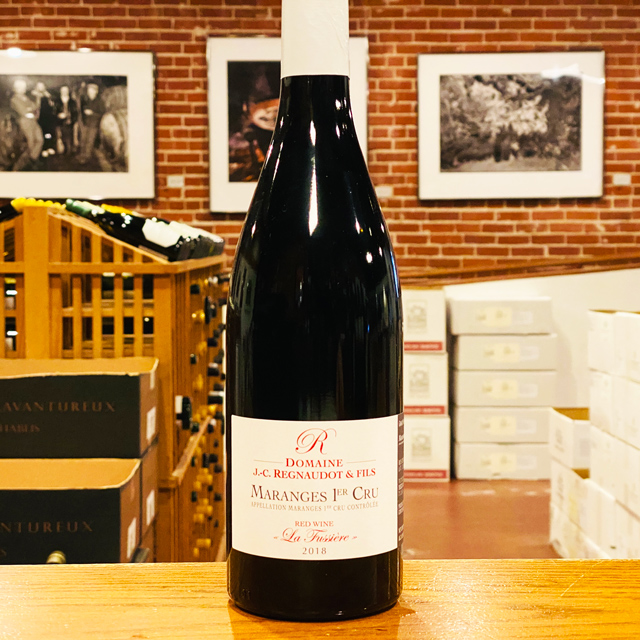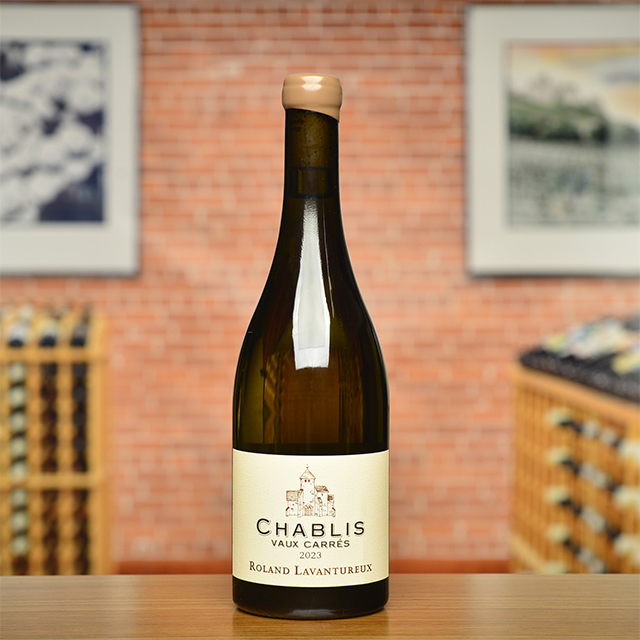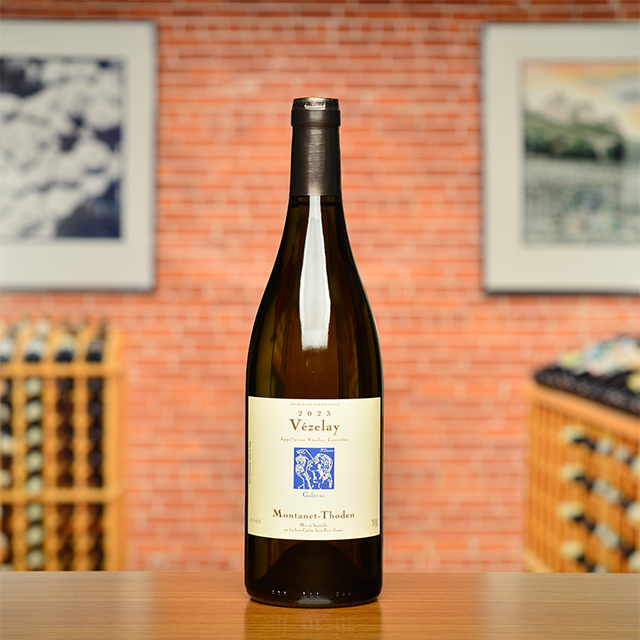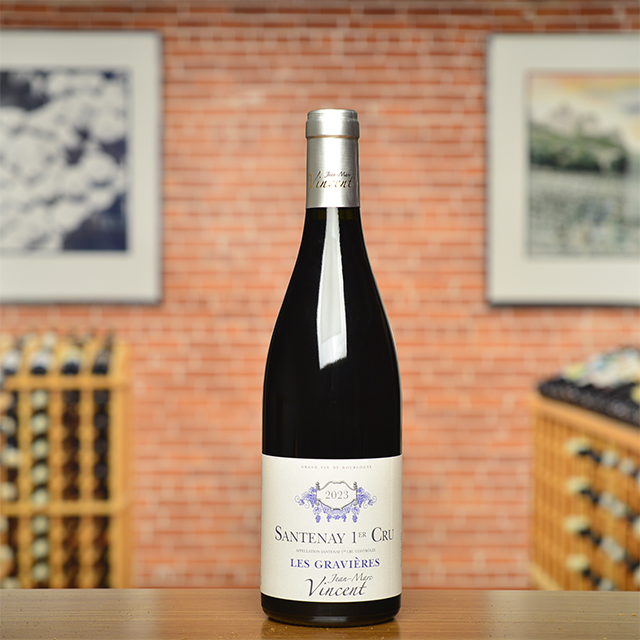Notify me
2018 Maranges 1er Cru “La Fussière”
Jean-Claude Regnaudot et Fils
One of our Chablis producers turned us on to Didier Regnaudot’s family domaine, tucked away in the hilly southwest corner of the Côte d’Or. It was a decision I’m sure he regretted almost immediately, since we promptly began to buy as much as they’d sell us, jeopardizing the chablisien’s supply of house red! Not surprisingly, the Regnaudot wines have become staff favorites, prized for their easygoing character and value. Didier’s La Fussière is robust and delicious, with the ripe fruit that characterizes the 2018 red Burgundies reined in by a subtle earthiness.
—Dustin Soiseth
| Wine Type: | red |
| Vintage: | 2018 |
| Bottle Size: | 750mL |
| Blend: | Pinot Noir |
| Appellation: | Maranges |
| Country: | France |
| Region: | Burgundy |
| Producer: | Domaine Jean-Claude Regnaudot |
| Winemaker: | Didier Regnaudot |
| Vineyard: | Planted in 1930, 1947, 1955, 1962, 1987; 1.12 ha |
| Soil: | Jurassic substrate, mainly black/grey marl |
| Farming: | Lutte Raisonnée |
| Alcohol: | 14.2% |
More from this Producer or Region

2023 Saint-Aubin 1er Cru “Sous Roche Dumay”
France | Burgundy
Masterfully showcasing the “noble reduction” that winemakers and consumers chase after, starting on an enticing hint of gunflint that gradually opens to hedonistic notes of butter and toast, remaining taut and poised throughout.

2023 Bourgogne Rouge “L’Ermitage”
France | Burgundy
A beautiful Cadette rouge with a bit more structure and plenty of pleasure.

2022 Nuits-Saint-Georges 1er Cru “Les Vaucrains”
France | Burgundy
Classic Nuits, the most structured wine in their book, legendary ager.

2023 Chablis “Vaux Carrés”
France | Burgundy
A crystal-clear translation of the Kimmeridgian limestone of Chablis—Chardonnay the way it can only taste from these soils.

2023 Bourgogne Vézelay Blanc “Galerne”
France | Burgundy
Valentin’s Galerne blanc is a divine rendition of pure, chiseled Chardonnay.

2022 Meursault 1er Cru “Genevrières”
France | Burgundy
Elegant aromas and a refined texture characterize this bottling from one of the village’s great vineyards.

1983 Charmes Chambertin Grand Cru
France | Burgundy
A classic Charmes, sensual and graceful, with a deep core of concentration.

2023 Chablis 1er Cru “Vaillons”
France | Burgundy
An element of luscious, tender fruit that seems to coat the wine’s spinal chord of Kimmeridgian minerals.

2018 Corton Rognet Grand Cru
France | Burgundy
An explosively aromatic Corton, impeccably balanced.

2022 Pernand-Vergelesses 1er Cru “Les Fichots”
France | Burgundy
With plush notes of red fruit and cocoa abounding in the glass, this Pernand punches way above its weight.
About The Producer
Domaine Jean-Claude Regnaudot
About The Region
Burgundy

In eastern central France, Burgundy is nestled between the wine regions of Champagne to the north, the Jura to the east, the Loire to the west, and the Rhône to the south. This is the terroir par excellence for producing world-class Pinot Noir and Chardonnay.
The southeast-facing hillside between Dijon in the north and Maranges in the south is known as the Côte d’Or or “golden slope.” The Côte d’Or comprises two main sections, both composed of limestone and clay soils: the Côte de Nuits in the northern sector, and the Côte de Beaune in the south. Both areas produce magnificent whites and reds, although the Côte de Beaune produces more white wine and the Côte de Nuits more red.
Chablis is Burgundy’s northern outpost, known for its flinty and age-worthy Chardonnays planted in Kimmeridgian limestone on an ancient seabed. Vézelay is a smaller area south of Chablis with similar qualities, although the limestone there is not Kimmeridgian.
To the south of the Côte de Beaune, the Côte Chalonnaise extends from Chagny on its northern end, down past Chalon-sur-Saône and encompasses the appellations of Bouzeron in the north, followed by Rully, Mercurey, Givry, and Montagny.
Directly south of the Chalonnaise begins the Côte Mâconnais, which extends south past Mâcon to the hamlets of Fuissé, Vinzelles, Chaintré, and Saint-Véran. The Mâconnais is prime Chardonnay country and contains an incredible diversity of soils.
More from Burgundy or France
2009 Aloxe-Corton 1er Cru “Les Vercots”
Domaine Follin-Arbelet France | Burgundy
2024 Chablis
Famille Savary France | Burgundy
2023 Saint-Aubin Rouge 1er Cru “Sur Le Sentier du Clou”
Domaine Larue France | Burgundy
2022 Marsannay Blanc “Les Longeroies”
René Bouvier France | Burgundy
2022 Chassagne-Montrachet Rouge “Vieilles Vignes”
Bruno Colin France | Burgundy
2023 Bourgogne Pinot Noir
René Bouvier France | Burgundy
2023 Givry Blanc “Clos des Vignes Rondes”
Domaine François Lumpp France | Burgundy
2023 Santenay Blanc 1er Cru “Le Beaurepaire”
Jean-Marc Vincent France | Burgundy
2023 Vézelay Blanc “La Châtelaine”
La Sœur Cadette France | Burgundy
2024 Petit Chablis
Famille Savary France | Burgundy
2022 Blagny Rouge 1er Cru “La Genelotte”
Domaine Comtesse de Chérisey France | Burgundy
2022 Rully Blanc 1er Cru “Rabourcé”
Domaine de Villaine France | Burgundy
2009 Aloxe-Corton 1er Cru “Les Vercots”
Domaine Follin-Arbelet France | Burgundy
2024 Chablis
Famille Savary France | Burgundy
2023 Saint-Aubin Rouge 1er Cru “Sur Le Sentier du Clou”
Domaine Larue France | Burgundy
2022 Marsannay Blanc “Les Longeroies”
René Bouvier France | Burgundy
2022 Chassagne-Montrachet Rouge “Vieilles Vignes”
Bruno Colin France | Burgundy
2023 Bourgogne Pinot Noir
René Bouvier France | Burgundy
2023 Givry Blanc “Clos des Vignes Rondes”
Domaine François Lumpp France | Burgundy
2023 Santenay Blanc 1er Cru “Le Beaurepaire”
Jean-Marc Vincent France | Burgundy
2023 Vézelay Blanc “La Châtelaine”
La Sœur Cadette France | Burgundy
2024 Petit Chablis
Famille Savary France | Burgundy
2022 Blagny Rouge 1er Cru “La Genelotte”
Domaine Comtesse de Chérisey France | Burgundy
2022 Rully Blanc 1er Cru “Rabourcé”
Domaine de Villaine France | Burgundy
Our Guarantee

Our Guarantee
We only import wine we drink and enjoy ourselves, directly from the source.
Our wine tastes the same in your home as it did where it was bottled in Europe.
Like the long-term relationships we build with growers, we build long-term relationships with our clients. Have a question? Need wine advice? Just give us a call—510-524-1524.


















